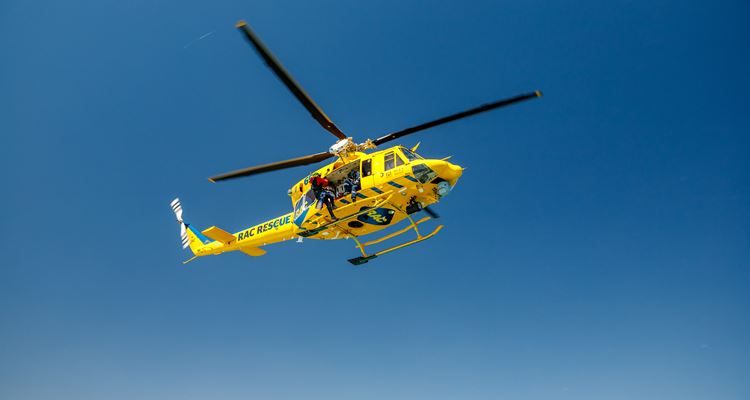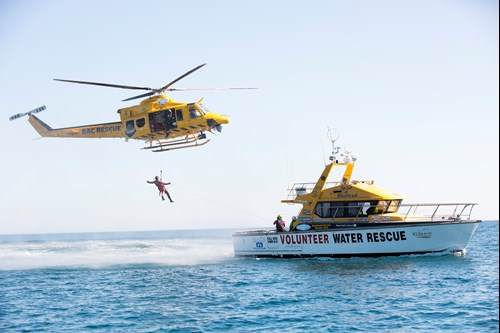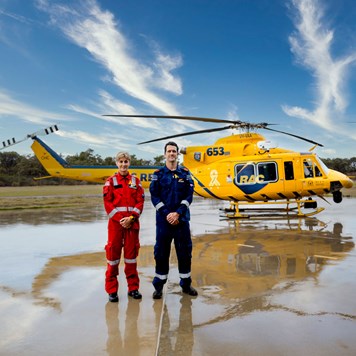Nine thousand lifesaving missions

On a clear winters day on Friday, 8 July, the State’s Emergency Rescue Helicopter Service, RAC Rescue, flew its 9000th mission to help a person in need.
This milestone represents thousands of lives saved and returned home.
The call comes in
Just before 11am, the on-shift Critical Care Paramedic answers a call from the triple-zero dispatcher, who confirms a 17-year-old boy is seriously injured after a quad bike rolled in the Lancelin sand dunes.
RAC Rescue is required to provide advanced medical care and rapid transport to a trauma hospital.
In a matter of seconds, the seasoned crew swing into action, remaining calm, focussed and efficient.
The pilot begins planning the mission, including how much fuel is needed, if they can safely land or if the aircraft hoist will be required to lift the patient onboard.
With the medical and drug kit ready to go on the chopper, the Critical Care Paramedic grabs extra specialist equipment and blood products in case transfusions are required.
The Aircrew Officer moves the helicopter out of the hangar and prepares the equipment.
In less than 15 minutes, the crew is on the way to give life-saving care.
Every minute matters
After a 53-minute flight, the helicopter lands on a nearby oval.
The Critical Care Paramedic quickly treats the patient, stabilises them for transport, and is then transferred to the helicopter.
RAC Rescue’s highly trained Critical Care Paramedics can place a patient in a medically induced coma, provide pain relief, give a blood transfusion and assist someone’s breathing all while in the air.
The pilot sets course for Royal Perth Hospital and lands on the rooftop heliport, where the patient is handed over to the medical team.
Thankfully, the teenager had non-life-threatening injuries.
Every mission is important
For each of these missions, there is a person whose life has been changed forever, whether it’s a significant injury requiring a lengthy hospital stay and rehabilitation or traumatic memories about the incident.
And tragically, despite the best efforts of first responders, at times patients don’t survive.
Since the first mission in August 2003, RAC Rescue has spent more than 20,000 hours flying across 1.8 million kilometres, equivalent to 47 times around the world, rescued 6,139 patients, responded to 4,579 road crash rescues and 948 search and rescues.
Based at Jandakot and Bunbury airports, RAC Rescue provides vital search and rescue and critical aeromedical services 24 hours a day, 365 days a year.

Emergency Services Commissioner Darren Klemm AFSM said Western Australia was the largest emergency services jurisdiction in the southern hemisphere and the crew and staff of RAC Rescue have done an outstanding job saving lives across our vast landscape.
“The highly trained crews can provide 24/7 rescue response and urgent medical care in the air, winch down to mountains or rough seas to treat and rescue a patient, respond to search and rescue missions over land and ocean and complete flood rescues,” he said.
“No two missions are the same. Past missions include evacuating patients off cargo and cruise ships, saving people stranded by flooding near Carnarvon and rescuing hikers caught on Bluff Knoll in severe weather.
“DFES is proud to operate RAC Rescue, a critical arm of the emergency services sector that works alongside career firefighters, DFES volunteers, WA Police Force, St John WA and the Australian Maritime Safety Authority.”
The RAC Rescue helicopters are sponsored by RAC funded by the State Government and managed by the Department of Fire and Emergency Services (DFES).
Have you or a loved one been rescued by the RAC Rescue helicopter?

If you’d like to share your story or meet the crew involved in your rescue, we would love to hear from you.
Please complete the event request form and we will be in touch.

